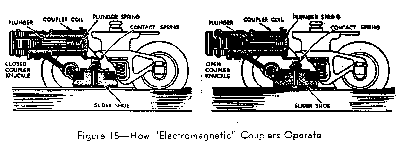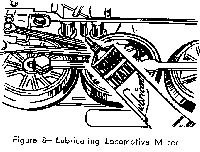
By the time you read this you have probably already unpacked and examined your train outfit. It is a good idea to save the boxes and corrugated board packing. They will come in handy for storing or transporting your equipment. Check the equipment to see that nothing is missing or broken. Spin all the car wheels to see that they turn freely (NOTE: some steamers wheels won't turn by hand. They will only turn under power.) And put a small dab of model train lubricant on the ends of the axles.
If your locomotive is one of those where the armature can be reached from the side, as illustrated in Figure 8, you should lubricate the ends of the armature shaft before you try to run it, or it may bind. (Locomotives of this type include a few older Lionel models and all old Marx locomotives.)

Place the locomotive and tender on the track and join them by means of the locomotive drawbar. If you have a diesel outfit, the power car should be first. The couple the rest of the cars by raising the end of the car and engaging the coupler by hand. (See Figure 9) If the couplers are open close them by pushing in the coupler knuckle until it snaps shut. The heaviest cars should generally be placed at the head of the train.
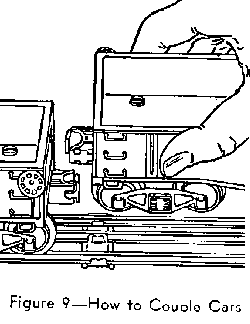
Make sure all the wheels of the locomotive and the cars are properly set on the track. If they are not, they may cause a "short circuit" on the track and the train will not operate.
There are several things you should know about your electrical power supply before you plug in your transformer or attempt to operate your train.
1) Never connect your outfit directly to an electrical out let. Always use a transformer. A transformer changes the high voltage electric power used in your house (usually 115 to 120 volts) to the low voltage used for operating toy trains (from 8 to 18 volts). The transformer cord is plugged into any convenient wall outlet. Low voltage is then obtained from the binding posts on top or in back of your transformer.
2) All household lines are not alike. Make sure that the voltage and frequency (cycles) of your electric power supply correspond to the rating of your transformer. If in doubt ask your electric company.
3) If you happen to have direct current (DC) a transformer cannot be used for it will burn out immediately. (Most regions of the US and Canada have alternating current (AC). DC is household current is rare.)
The speed of the train is varied by moving the voltage control on the transformer panel. The higher the voltage, the greater the speed. Some transformers provide at least two different voltage ranges. The lower range is used for light trains; the higher range for heavier trains. Always try the lowest range first; use the high range only if the train does not go fast enough. When running the train keep one hand on the voltage control. In this way you will be able to slow the train down on curves, speed it up along the straight-away or bring it to a gradual stop at the uncoupling section.
Lionel locomotives can be stopped and reversed by remote control. The reversing mechanism is known as the "E-Unit." It is mounted within the locomotive and is operated by momentary interruptions of current to the track. This operation can be performed at any distance from the locomotive either by operating the "Direction" control on the transformer, or by turning the voltage control to the "OFF" position. (The accidental "shorting" of the track, or disconnecting one of the current-carrying-wires will also cause the E-Unit to operate.)
The E-Unit has three positions which operate in rotation: Forward, Stop, Reverse, Stop, etc. When the locomotive is running move the "Direction" control once to stop it and twice to reverse it. The Stop or Neutral position enables the locomotive to stand still even though power for lights, accessories, etc. is still supplied to the track.
NOTE: old Marx and some Lionel locomotives (#6110, for instance) is an exception to this general rule since their reversing mechanism does not have a neutral position, but moves from "Forward" directly to "Reverse."
The E-Unit can be disconnected by pushing the E-Unit lever to the OFF position. Then the same locomotive will not reverse automatically but will always run in the same direction. To disconnect the E-Unit start the locomotive going in the desired direction; stop it with your hand while power is on; then move the E-Unit to OFF. Figure 10 shows the location of the E-unit lever in three types of locomotives.
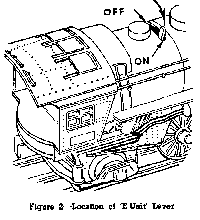
For normal operation the E-Unit lever should be left ON in order to take advantage of the remote control of the locomotive direction. It should be moved to OFF when operating the train together with an automatic stop station, operating bridge or insulated block, as described elsewhere on this site.
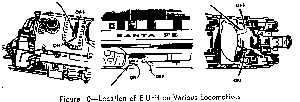
NOTE: If the E-Unit is disconnected while it is in a Stop position, the locomotive will not start at all. Also, because it is operated partly by gravity the E-unit will not work if the locomotive is placed on its side or held upside-down.
Following actual railroading practice most steam-type trains are equipped with a two-tone whistle, while the electric and diesel types contain a horn. The whistle is mounted in the locomotive tender, while the horn is located in the electric locomotive itself and in the power car of the twin diesel. Both the whistle and the horn can be sounded anywhere on the track by operating the whistle controller.
In most modern transformers the whistle controller is built into the transformer and is operated by a button or level on the transformer panel. If your transformer does not have a built-in whistle controller, an external controller must be used.
The power for operating the whistle is supplied by the track itself, but the horns on many older (pre-1970) diesel and electric locomotives use a flashlight cell which must be inserted into the locomotive as shown in Figure 11. When the cell is worn out, it can be replaced by any standard size D flashlight cell.
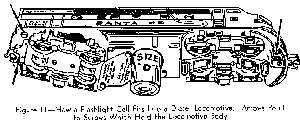
Most troubles in running an electric train are caused by accidental short circuits. A short circuit is a direct connection between two transformer posts. It is caused most often by a derailed wheel touching the center rail and the outside rail. A short circuit causes an excessive current to be drawn from the transformer. When a short circuit occurs, the train stops, the lights dim or go out altogether; the transformer overheats and, if unprotected, will burn out.
To protect the transformer from the danger of burn-outs most modern transformers are equipped with built-in circuit breakers. If too great a current is drawn from the transformer, the circuit breaker opens and cuts off all power from the track. In a few second the circuit breaker resets automatically but will reopen almost immediately if the short circuit still exists.
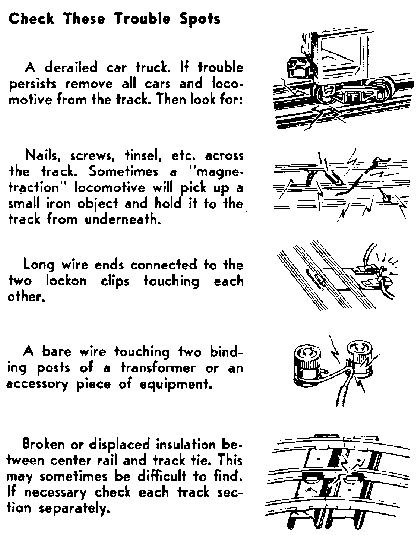
Remote control track consists of a two-button controller wired to a special track section which has five rails and a centrally-located built-in electromagnet. The remote track sections are inserted into the layout as any ordinary track and are used to uncouple cars or to operate automatic unloading cars. Remote track sets can be purchased and installed to permit uncoupling and operation of cars in as many placed in the layout as you wish. It is best to have one regular straight section on either side of the special track.
NOTE: an O27 Uncoupling track consisting of three rails and electromagnet is also available. It will perform uncoupling and work those cars operated solely by the electromagnet, but not cars requiring five rails. Those requiring five rails have a shoe under the truck, near the wheel.
All standard O / O27 cars and tenders, as well as switching, electric and diesel locomotives, are equipped with operating railroad-knuckle couplers. Although two types of couplers are used -- the "electro-magnetic" for locomotives and for extra-long cars and the "magnetic" for most ordinary cars--both can be opened by the same Remote Control Track,
To open a closed "magnetic" coupler move the car so the front wheels are over the central electro-magnet; then press the "Uncouple" button. The coupler can be uncoupled while the car is in motion by pressing the "Uncouple" button at the proper moment.

To open a closed "electro-magnetic" coupler move the car so that the sliding shoe underneath the truck you want opened rides up on one of the control rails; then push the uncouple" button.
Both types of couplers are closed simply by pushing the open knuckle in until
it latches, so to couple any two cars just push them together. Only one of
the mating couplers has to be open for the cars to couple or
uncouple.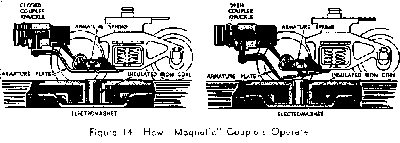
Cars or locomotives equipped with "electro-magnetic" couplers are wired so that both couplers open when the "uncouple" button is pressed. "Magnetic" couplers can be opened separately.
